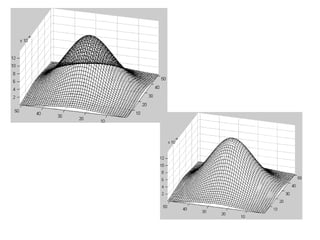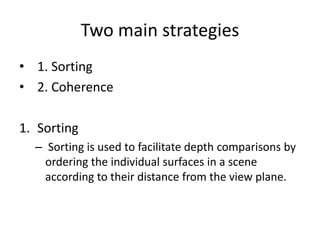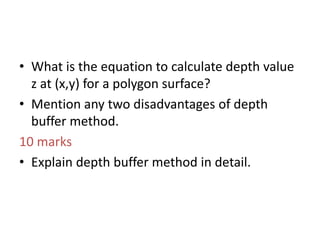Computer Graphics: Visible surface detection methods
- 2. Outline of Presentation 1. Introduction 2. Classification 3. Depth-Buffer Algorithm
- 3. 1. Introduction • A set of 3-D surfaces are to be projected onto a 2-D screen. • To identify those parts of a scene that are visible from a chosen viewing position. • Correct visibility – when multiple opaque polygons cover the same screen space, only the closest one is visible.
- 4. Visibility
- 6. • There are many algorithms developed and still being developed for visible surface detection or Hidden surface removal. • Characteristics of approaches: – Require large memory size. – Require long processing time. – Applicable to which types of objects?
- 7. • Considerations: – Complexity of the scene – Type of objects in the scene – Available equipment – Static or animated? • Visible-surface detection methods and hidden-surface elimination methods are similar but distinct.
- 8. 2. Classification • Visible-surface detection algorithms are broadly classified into 2 types. 1. Object –space methods 2. Image-space methods
- 9. Object-space methods • Deals with object definitions directly. • Compare objects and parts of objects to each other within the scene definition to determine which surfaces, as a whole, we should label as visible. • It is a continuous method. • Compare each object with all other objects to determine the visibility of the object parts.
- 10. Pros and Cons of Object-space Methods • If there are n objects in the scene, complexity = O(n2) • Calculations are performed at the resolution in which the objects are defined (only limited by the computation hardware). • Process is unrelated to display resolution or the individual pixel in the image and the result of the process is applicable to different display resolutions.
- 11. • Display is more accurate but computationally more expensive as compared to image space • methods are typically more complex, due to the possibility of intersection between surfaces. • Suitable for scene with small number of objects and objects with simple relationship with each other.
- 12. Image Space methods • Deals with the projected images of the objects and not directly with objects. • Visibility is determined point by point at each pixel position on the projection plane. • It is a discrete method. • Accuracy of the calculation is bounded by the display resolution. • A change of display resolution requires re- calculation
- 13. Two main strategies • 1. Sorting • 2. Coherence 1. Sorting – Sorting is used to facilitate depth comparisons by ordering the individual surfaces in a scene according to their distance from the view plane.
- 14. Coherence • Making use of the results calculated for one part of the scene or image for other nearby parts. • Coherence is the result of local similarity • As objects have continuous spatial extent, object properties vary smoothly within a small local region in the scene. • Calculations can then be made incremental.
- 15. 3. Depth-Buffer Method (Z-Buffer Method) • It is a commonly used image-space approach to detecting visible surfaces proposed by Catmull in 1974. • It compares the surface depths at each pixel position on the projection plane. • Object depth is usually measured from the view plane along the z axis of a viewing system. • Each surface of a scene is processed separately, one point at a time across the surface.
- 16. • This method requires 2 buffers: 1) Depth buffer or z-buffer: • To store the depth values for each (X, Y) position, as surfaces are processed. • 0 ≤ depth ≤ 1 2) Refresh Buffer or Frame Buffer: • To store the intensity value or Color value at each position (X, Y).
- 18. Algorithm 1. depthbuffer(x,y) = 0 framebuffer(x,y) = background color 2. Process each polygon one at a time 2.1. For each projected (x,y) pixel position of a polygon, calculate depth z. 2.2. If z > depthbuffer(x,y) compute surface color, set depthbuffer(x,y) = z, framebuffer(x,y) = surfacecolor(x,y)
- 19. Example • The Final Image Z = 0.3 Z = 0.5
- 20. • Step 1: Initialize the depth buffer 0 0 0 0 0 0 0 0 0 0 0 0 0 0 0 0
- 21. • Step 2: Draw the polygon with depth 0.3 (2.2) 0 0 0 0 0 0 0 0 0.3 0.3 0 0 0.3 0.3 0 0
- 22. • Step 3: Draw the polygon with depth 0.5 0 0 0 0 0 0.5 0.5 0 0.3 0.5 0.5 0 0.3 0.3 0 0
- 23. Calculating Depth • We know the depth values at the vertices. • we can calculate the depth at any other point on the surface of the polygon using the polygon surface equation: C DByAx z
- 25. • For any scan line adjacent horizontal x positions or vertical y positions differ by 1 unit. • The depth value of the next position (x+1,y) on the scan line can be obtained using C A z C DByxA z )1(
- 26. • For adjacent scan-lines we can compute the x value using the slope of the projected line and the previous x value. C BmA z m xx / z 1
- 27. Pros and Cons • Widely used • Simple to implement • Needs large amount of memory (uses 2 buffers) • Aliasing problem. • Handle only opaque surfaces • Problem when too many surfaces are there.
- 28. Questions 2 marks • What is the task of visible detection methods? • What is correct visibility? • What are the types of visible detection algorithms? • Difference between object space methods and image space methods?
- 29. • What are the two strategies used in visible surface detection algorithms? • What is coherence in image space methods? • Mention two advantages of object space method. • Mention two disadvantages of object space method. • What are the disadvantages of Image space method?
- 30. • What are the buffers used in Depth buffer method? • What is the content of Z-buffer? • What is the content of refresh buffer? • What are the initial values of depth buffer and refresh buffer? • What is the range of depth used in depth buffer method?
- 31. • What is the equation to calculate depth value z at (x,y) for a polygon surface? • Mention any two disadvantages of depth buffer method. 10 marks • Explain depth buffer method in detail.
- 32. Quote If you have a ‘why’ to live for, you can cope with any ‘how’.
- 33. Thank you!

































